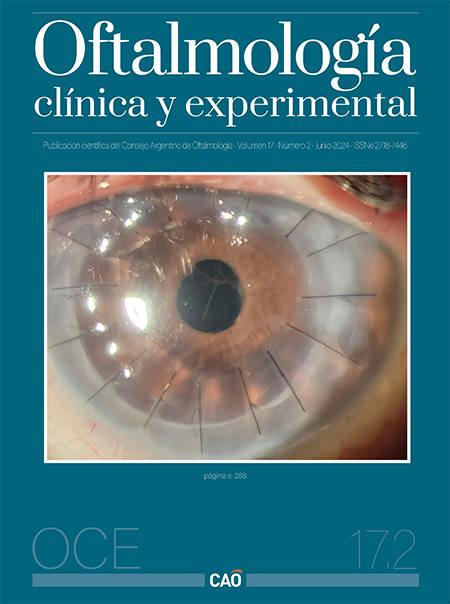Diffuse bacterial keratitis in patients with bullous keratopathy
DOI:
https://doi.org/10.70313/2718.7446.v17.n02.331Keywords:
bullous keratopathy, bacterial keratitis, infectious keratitis, fortified antibioticsAbstract
There are different causes of corneal endothelial decompensation. Clinically it causes a condition called bullous keratitis, in which corneal edema is observed with loss of transparency and structural alteration manifested by recurrent cycles of bullous lesions in the corneal epithelium. The aim of this work is to report a series of cases of patients with bullous keratopathy who presented corneal infectious keratitis whose main sign was hypopyon. After taking a sample for direct examination and culture, treatment with fortified eye drops (vancomycin 50 mg/ml and ceftazidime 50 mg/ml) was performed, obtaining a satisfactory response, in the context of bacterial infections. It is emphasized to consider bullous keratopathy as a risk factor for infectious keratitis, being possible to have corneal bacterial infection without ulceration or evident infiltration at the moment, being the presence of hypopyon the only sign of corneal infection in the presented cases.
References
Austin A, Lietman T, Rose-Nussbaumer J. Update on the management of infectious keratitis. Ophthalmology 2017; 124: 1678-1689.
Ljubimov AV, Atilano SR, Garner MH et al. Extracellular matrix and Na+, K+-ATPase in human corneas following cataract surgery: comparison with bullous keratopathy and Fuchs’ dystrophy corneas. Cornea 2002; 21: 74-80.
Gomes JAP, Haraguchi DKM, Zambrano DU et al. Punções do estroma anterior no tratamento da ceratopatia bolhosa. Arq Bras Oftalmol 2000; 63: 133-137.
Wollensak G, Green WR, Seiler T. Corneal myxoma. Jpn J Ophthalmol 2002; 46: 193-197.
Morishige N, Sonoda KH. Bullous keratopathy as a progressive disease: evidence from clinical and laboratory imaging studies. Cornea 2013; 32 Suppl 1: S77-S83.
Gonçalves ED, Campos M, Paris F et al. Ceratopatia bolhosa: etiopatogênese e tratamento. Arq Bras Oftalmol 2008; 71 (6 Suppl): 61-64.
Eaton JS, Miller PE, Bentley E et al. The SPOTS system: an ocular scoring system optimized for use in modern preclinical drug development and toxicology. J Ocul Pharmacol Ther 2017; 33: 718-734.
Ung L, Bispo PJM, Shanbhag SS et al. The persistent dilemma of microbial keratitis: global burden, diagnosis, and antimicrobial resistance. Surv Ophthalmol 2019; 64: 255-271.
Kaye SB, Rao PG, Smith G et al. Simplifying collection of corneal specimens in cases of suspected bacterial keratitis. J Clin Microbiol 2003; 41: 3192-3197.
Grandi G, Bianco G, Boattini et al. Bacterial etiology and antimicrobial resistance trends in ocular infections: a 30- year study, Turin area, Italy. Eur J Ophtalmol 2021; 31: 405-414.
Acharya M, Farooqui JH, Gaba T et al. Delhi infectious keratitis study: update on clínico-microbiological profile and outcomes of infectious keratitis. J Curr Ophtalmol 2020; 32: 249-255.
Kansky JJ. Oftalmología clínica. Barcelona: Elseiver España, 2016.
Fernández Ferreiro A, González-Barcia M, Gil-Martínez M et al. Evaluation of the in vitro ocular toxicity of the fortified antibiotic eye drops prepared at the Hospital Pharmacy Departments. Farm Hosp 2016; 40: 352-370.
Siu GD, Young AL, Jhanji V. Alternatives to corneal transplantation for the management of bullous keratopathy. Curr Opin Ophthalmol 2014; 25: 347-352.
Singh M, Sinha BP, Mishra D et al. Role of corneal collagen cross-linking in bullous keratopathy: a systematic review. Indian J Ophthalmol 2023; 71: 1706-1717.
Published
How to Cite
Issue
Section
License
Copyright (c) 2024 Consejo Argentino de Oftalmología

This work is licensed under a Creative Commons Attribution-NonCommercial-NoDerivatives 4.0 International License.
Con esta licencia no se permite un uso comercial de la obra original, ni la generación de obras derivadas. Las licencias Creative Commons permiten a los autores compartir y liberar sus obras en forma legal y segura.







